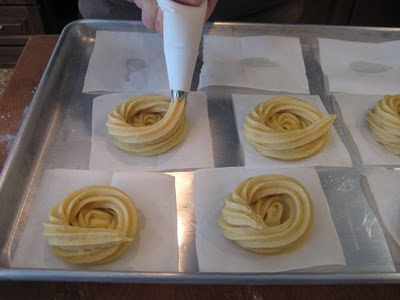(This is a tag-team article. After reading this article, click on the link provided below and read food writer, Marcella DeVincenzo’s take on Zeppole in Montreal.)
 Fig.1. Zeppole di San Giuseppe: fried dough and cream. Simple and good.
Fig.1. Zeppole di San Giuseppe: fried dough and cream. Simple and good.The history behind zeppole di San Giuseppe isn’t well documented. Some historians speculate it derives from around 500AD during an annual festival held in mid-March when the Romans would honor their wine god, Bacchus, and their wheat god, Silinus, by consuming copious amounts of wine and fried dough. St Joseph’s day, a patronage still celebrated in Italy today amid large feasts and celebrations, also takes place in mid-March, March 19th to be exact; somewhere along the course of history, Silinus and St Joseph were bestowed with a zeppole.
Many also believe that St Joseph is the patron saint of pastry chefs, this is wrong, at least according to the Vatican. St Joseph is actually the patron saint of confectioners; St Honoré is in charge of pastries and the people who make them. All of you pastry chefs with a charm of St Joseph around your neck, don’t blame me, take it up with Benedict, or, start making confections.
One thing seems for certain, the modern day zeppole originated in the south—probably Naples, but many Sicilians would disagree. In Sicily, the zeppole is often referred to as a sfinzi. Pre-1950 zeppole recipes usually contained yeast, and had mashed potatoes, flour and semolina as the main ingredients. The zeppole were finished with a roll in sugar or a drizzle of honey; the creamy fillings came later.
Regarding the etymology of the name and some historical background, food historian Clifford A. Wright, author of, A Mediterranean Feast, had this to say:
The medieval Arab zalābiyya, a kind of deep-fried
doughnut sprinkled with sugar, exists today, both
with that name and many others, including sifanj.
Sifanj, coming from the Arabic word for “sponge,”
[..]This sifanj exists in Sicily, too, where it is called
sfinci (or sfìncia) the word also derived from the
Arabic.
East and North End Bakeries
The original idea for this post was to find a zeppole in Montreal similar to the one's being made in Italy at present. Zeppole, of course, as with all Italian fare, change depending on the region of Italy you’re in; there is one constant in Italy however: the zeppole are usually fresh. (Day old zeppole are sold as such and at a reduced price.) Italian bakeries in Montreal all sell zeppoles this time of year. I did a zeppole run of the usual bakeries in the East End; what I hoped to find were fresh, fried pieces of dough, just out of the fryer and piped with a fresh cream, what I found rather, were substandard, precooked pastries, void of love. To the vast majority of Italian bakeries in Montreal I say this: Fry them fresh and they will come. (and while you’re looking at the zeppole, you might want to do something about your bread too.)
So while there isn't much going on in the way of edible zeppole in the East and North End of Montreal, can Little Italy provide us with zeppole good enough for St. Joseph to bless? Find out what Marcella DeVincenzo, aka. EatalianGirl, has to say in the continuation of this zeppole reportage on http://www.eataliangirl.com/?p=326
Zeppole Di San Giuseppe
Makes 8 to 9 zeppole
 Fig.2. Topped with last year's blueberry jam.
Fig.2. Topped with last year's blueberry jam. This recipe comes straight from Italy. Nothing complicated here: a fried piece of dough filled with cream. All I ask is that you eat it the same day you make it. Day old zeppole can be reheated in an oven.
When deep-frying anything, be careful. Have a lid to cover the pot of oil near you at all times (should the oil catch on fire, just put the lid on it.) and a small kitchen fire extinguisher is also a good idea. This is a perfect recipe for a deep-fryer.
For the dough:
250 ml (or 1 cup+2tbsp) water
70 grams unsalted butter
1 tbsp vanilla extract
150 grams (or 1 cup) 00flour
40 grams (or 3 tbsp) sugar
1/4 tsp salt
zest of 1 lemon
3 eggs
For the filling:
1 cup ricotta
1/4 cup maple syrup
zest of 1/2 a lemon
Directions:
In a medium heavy-bottom pot, bring the water, butter and vanilla extract to a simmer. Once the liquid is simmering, and all of the butter completely melted, add the flour, all at once to the simmering liquid and stir (using a wooden spoon) until you have a unified ball of dough. Turn the heat to low and continue stirring the ball around for 2 minutes to cook off some of the moisture in the dough. Transfer the ball of dough into a large bowl, spread it out a little and let it cool down (Don’t let it get too cold, it should be warm, but not hot, for the next step) Add the sugar, salt and lemon zest and stir. Add the eggs one at a time, adding the next egg only after the first is completely incorporated. (You can use a stand mixer for this step. Also, when the egg is added, your dough will at first look like it separated into pieces, this is normal. Keep mixing vigorously and the batter will come back together.) Scoop the batter into a piping bag and set aside.
Cut nine, 4”x4” squares of parchment paper. Place the paper squares on a cookie sheet, make sure they are flat, (it’s important that the paper not move while you’re piping) I like to dab the bottom of the parchment with corn syrup so it sticks to the cookie sheet. Starting in the center of the paper, pipe the batter in a circular motion with every new circle resting just outside the other (see picture fig) For the last circle, pipe on top of the outer circle, forming a border. (If you wish to keep things simple, you can just pipe the batter to form a ring, like a doughnut.)
Pour three inches of oil in a deep pan or pot. Heat the oil to a temperature between 325 degrees F to 335 degrees F. (You really need an oil thermometer for this.) Slide the zeppole into the hot oil with the parchment paper and fry zeppole, about 8 minutes on one side and 6 to 7 minutes on the other. (Do not fry more than two zeppole at a time and you can remove the parchment paper a couple of minutes after it's placed in the oil. Don't worry, the paper won't burn.) It's important that the zeppole be completely covered in oil for several minutes so that the center (or hole) of the zeppole cooks through. Once the zeppole are a deep, golden brown, transfer to a cookie sheet lined with paper towels to cool.
To prepare the filling, simply whip (it's best to use a mixer for this) 1 cup of ricotta with 1/4 cup maple syrup, and the lemon zest. (I used maple syrup and a blueberry topping in an effort to keep things local and in season, feel free to add sugar to the ricotta if you wish. How much to add is up to you.) Whip on medium speed for about 5 to 6 minutes, until very creamy. Pipe (or spoon) the ricotta into the zeppole, top with whatever you want (Stay away from the red maraschino cherries, the sulfur dioxide they are brined in will kill you. In Italy, zeppole are usually topped with black sour cherries. If you made a jam last fall, use that.)

 Fig.4. On the last go-around, pipe on top of the outer circle, creating a border.
Fig.4. On the last go-around, pipe on top of the outer circle, creating a border. 
Fig.5. Holding the corners of the parchment paper, slip the zeppole and paper into the oil. Do not use wax paper!

Fig.6. After a couple of minutes, remove the parchment paper with some kitchen tongs.

Fig.7. Stick the tip into the zeppole and pipe, filling the pastry.
 Fig.8. Sprinkle with powdered sugar and eat. I made these with my son and we pigged out. Looking forward to doing it with him again next year.
Fig.8. Sprinkle with powdered sugar and eat. I made these with my son and we pigged out. Looking forward to doing it with him again next year.
1 comment:
pigged out indeed! We want more Italian goodies like this per favore
Post a Comment